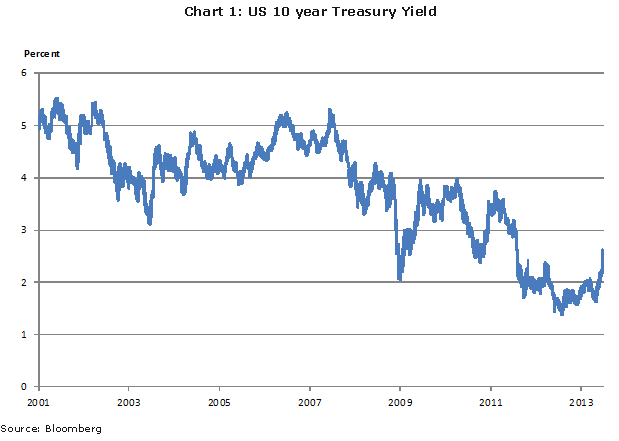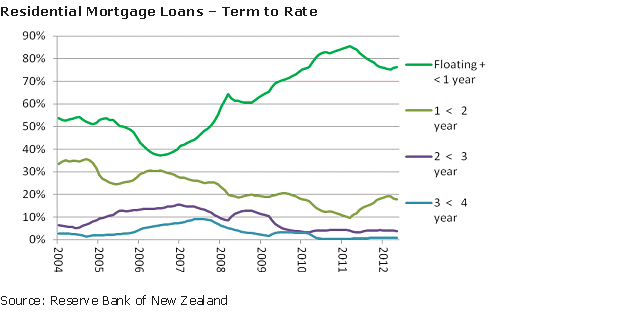Harbour Monthly Commentary: Bond Market Blues
Super-low interest rates may be a thing of the past as the US moves away from QE and towards more normalised monetary policy
Friday, July 5th 2013, 5:59AM
by Harbour Asset Management
- The bond market sell-off that started in May, continued in June, as the US Federal Reserve upgraded their economic outlook and outlined a possible timeframe for easing back on QE (Quantitative Easing).
- Long-term bond yields rose, with NZ and US 10 year yields rising 35bps and 56bps respectively. NZ 10 year yields have risen 96bps in two months. The market move was characterised by high volatility and poor liquidity, as investors rushed to abandon the ‘carry trades’ that were reliant on ongoing low cash rates.
- Returns for long duration assets were the worst. The ANZ NZ Government Stock Index rolling 12 month return fell to just 0.03%, while the ANZ Corporate A-Grade Index return was 4.49% over the same period.
- A new mindset towards fixed interest looks to be in play. The previous focus on searching for yield and income looks to have been replaced by an aversion to interest rate sensitive assets. As the US and NZ economies steadily improve, further rises in bond yields seem likely.
- The RBNZ remains steadfastly on hold, despite surging confidence, the strong housing market, increased activity in Canterbury and a lower NZ Dollar.
Don’t Fight the Fed
Ever since QE was first launched in the aftermath of the GFC, central banks and investors have been pondering exit strategies and how markets and economies might manage through this phase. During May and now June, we have had a taste of that. So far, it has not been all that different to previous turning points in market trends. The biggest surprise has been that the Fed has led the way.
Throughout the years of extraordinary policy measures, the Fed has emphasized that it will take it's time over removal of stimulus. The tone was reinforced by the Evan’s Rule initiative , whereby the Fed stated they would maintain a loose policy stance as long as the unemployment rate remains above 6.5% and inflation is below 2.5%. These preconditions have not yet been met and indeed the Fed do not expect to be hiking the Fed Funds Rate within the next 12 months.
However, while the Fed Funds rate will not change for some time, QE may be eased back. (‘Tapered’ is the Fed’s chosen adjective.) In June the Fed followed up hints made in May by saying that the FOMC “may moderate purchases later in 2013” if the economy continues to improve as expected. The market was surprised by both the Fed’s confidence in the economy as well as the more specific indication that QE bond purchases would be reduced.

Up until recently, many investors have been relying on the Fed’s signals that rates will stay lower for longer to enter carry trades, buying an asset that provides a better yield than cash. Fixed interest assets and high yield defensive equities are the most obvious targets for this investment strategy. Investors have favoured emerging market bonds and high yield corporate debt, as well as standard investment grade debt. Even currencies such as the Australian and New Zealand Dollars find favour, as low US interest rates lead investors to expect the US Dollar to fall.
So when the Fed abruptly changed the message, many investors sought to exit these positions. The act of rushing for the same door has been made more challenging, as banks have less capacity to hold the risk positions they accept as part of market-making, due to post-GFC financial stability legislation. Forced to offload positions back into the market, prices became more volatile and liquidity deteriorated. At its’ peak US 10 year bond yields reached 2.67% in June, having traded at 1.62% early in May. By the end of June yields had fallen back a little, to 2.49%.

Taking a step back from the near-term volatility, many see the Fed’s announcement as a clear signal that the multi-year trend of lower interest rates is now over. While economic data has been rather underwhelming, it has been sufficiently strong to give the Fed confidence to move a step closer to normalizing monetary policy. “Don’t Fight the Fed” is a common refrain at present.
RBNZ is not reading the same script
While the Fed has surprised by signaling a change in stance earlier than expected, the RBNZ has been stridently on hold, despite a recent run of very upbeat data. Over the last month this includes:-
- Fonterra has announced a projected payout of $7.00 for the 2013/14 season, up from $5.80 this year. Many farms appear to have recovered well from the drought and anecdotes from the National Field-days at Mystery Creek were mostly surprisingly strong;
- The ANZ Business Outlook has firms’ Own Activity Outlook at a high net 45% positive;
- The Westpac: McDermott Miller Consumer confidence index has risen to its’ highest level in 3 years;
- Net migration is lifting as job prospects in NZ are looking stronger than in Australia;
- Building consents have lifted sharply;
- Auckland house prices are hitting new highs;
- The NZ Dollar Trade-weighted index is down over 6% over the last two months.

The Reserve Banks’ emphasis has been predominantly on the housing market and the related systemic risks to the financial sector. The groundwork is being prepared to launch LVR-based policies, which will probably restrain lending to the most at risk, high LVR borrowers. At present, with inflation still near the bottom of the target range, the RBNZ is reluctant to signal any imminent hike to the OCR. The argument that a higher OCR might drive the NZD higher is part of their message.
For most people, the main message is that mortgage rates aren’t going to race higher yet. At this stage, the RBNZ does not seem to want to use a higher OCR to quell the housing market. This signal, combined with competition for market share, has enabled one and two year mortgage rates to be around the lowest seen over recent years. Households are responding.
As the vast majority of outstanding mortgages are on floating terms (or reprice within 12 months), sensitivity to higher mortgage rates is therefore quite high.
This has two implications. Firstly, the RBNZ can readily get traction with monetary policy, as a rate hike would be felt rapidly by most people. The second aspect is that a clear signal of imminent hikes could cause a flood of people fixing mortgages. Collectively, this would be likely to push up wholesale market rates around the 2-3 year part of the yield curve higher. Even at present, the preference for 2 year fixed rate is being felt. These aspects make decision-making and communication a challenging task for the Reserve Bank. When one also considers the supply issues, migration and the esoteric nature of macroprudential tools (such as LVR limits), housing has become a real can of worms that looks likely to be difficult to handle for some time.

Looking at the broader economy, it appears that stronger activity may be spreading beyond the familiar Canterbury/Auckland housing sectors. Consequently, inflation pressures may build faster than the RBNZ currently anticipates. If so, the market may argue that the RBNZ is a little behind the curve. The two year swap rate rose by 0.23% to 3.17% in June.
Market Outlook
Bond yields have risen sharply since the beginning of May, and there is some chance they have overshot in the short term. However, it now seems that it would take a real downturn in US data to get the Fed to completely step away from a scenario of tapering QE. We think that we would need to see weaker data or re-emergence of global stress to get US 10 years bonds back towards 2.0%.
This creates a significant change in the previous market psychology. While many analysts believed higher interest rates were just a matter of time, there have been many others prepared to ride the carry trades. The latter group will now be more wary of the risks, even though yields are now more attractive than they were a month ago. Indeed the Fed has noted the risks around the market relying excessively on the QE policy and is probably not unhappy to have seen investors become more circumspect.
It seems probable that long-term yields will continue to rise over time. However, the key investment questions are “how far and how quickly?” These issues have a significant bearing on optimal investment strategy. Looking at valuation of the long-term end of the NZ swap curve, we can see that the market is pricing a five year swap rate, at five years in the future at 5.30%. Currently, the five year swap rate is 3.90%. With local analysts viewing a neutral OCR around 4.5% going forward, it appears five year forward rates do not need to go a lot higher. We do not expect, at present, that yields will return to pre-GFC levels.

Despite these longer term valuation observations, we see scope for heightened uncertainty, and perhaps also ongoing volatility, as the market goes through a phase of recalibrating expectations and a re-establishing a sense of value. As described above, there is scope for surprises both domestically and globally.
Mark Brown
Director, Fixed Interest
Harbour Asset Management
IMPORTANT DISCLAIMER INFORMATION
Important disclaimer information
| « Tyndall Monthly Commentary: Addicted to Quantitative Easing | Hamish Douglass Unplugged - Latest Video from Adviser Briefing - August 2012 » |
Special Offers
Comments from our readers
No comments yet
Sign In to add your comment
| Printable version | Email to a friend |









